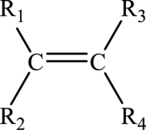
Interpretation:
The open-chain structures for the given molecular formula,
Concept Introduction:
Hydrocarbons:
Hydrocarbons contain only carbon and hydrogen atoms which are connected together by covalent bonds such as
Alkenes are unsaturated hydrocarbon that must contain atleast one carbon-carbon double bond in it. The generalized molecular formula for alkenes is represented as
The general formula of alkene is drawn here:

Alkynes:
Alkynes are unsaturated hydrocarbon that must contain a carbon-carbon triple bond in it. The generalized molecular formula for open-chain alkanes is represented as
The general structure of alkyne is shown here:

Want to see the full answer?
Check out a sample textbook solution
Chapter 19 Solutions
FOUND.OF COLLEGE CHEMISTRY
- Summarize the nomenclature rules for alkanes, alkenes, alkynes, and aromatic compounds. Correct the following false statements regarding nomenclature of hydrocarbons. a. The root name for a hydrocarbon is based on the shortest continuous chain of carbon atoms. b. The suffix used to name all hydrocarbons is -ane. c. Substituent groups are numbered so as to give the largest numbers possible. d. No number is required to indicate the positions of double or triple bonds in alkenes and alkynes. e. Substituent groups get the lowest number possible in alkenes and alkynes. f. The ortho- term in aromatic hydrocarbons indicates the presence of two substituent groups bonded to carbon- 1 and carbon-3 in benzene.arrow_forwardHow does the structure of a cycloalkane differ from that of a straight-chain or branched-chain alkane?arrow_forwardAlcohols A, B and C all have the composition C4H 100. Molecules of alcohol A contain a branched carbon chain and can be oxidized to an aldehyde; molecules of alcohol B contain a linear carbon chain and can be oxidized to a ketone; and molecules of alcohol C can be oxidized to neither an aldehyde nor a ketone. Write the Lewis structures of these molecules.arrow_forward
- Write structures for the three isomers of the aromatic hydrocarbon xylene, C6H4(CH3)2.arrow_forwardGasohol is a mixture of 90% gasoline and 10% ethanol, CH 3CH 2OH. Ethanol is considered an environmentally friendly fuel additive because it can be made from a renewable source—sugarcane. Ethanol burns in air to form CO 2 and H 2O, and, like the combustion of alkanes, this reaction also releases a great deal of energy. Write a balanced equation for the combustion of ethanol.arrow_forwardWhat is the molecular formula of a hydrocarbon that contains 5 carbons, one ring, and one bond?arrow_forward
- The following is a structural diagram for penicillin G, an antibiotic compound with outstanding antibacterial activity. It is obtained from the liquid filtrate of molds. HO H H H C-C N- H Penicillin G can be described as an Organic Co -N- organic inorganic CH₂ H CH₂ -COOH compound. One functional group found in penicillin G is the ◆ grouparrow_forwardHydrocarbons containing carbon-carbon triple bonds are called ____. A hydrocarbon substituent that has the general formula of CnH2n +1 is called ____. The simplest aromatic compound with an -OH functional group is called ____.arrow_forwardThe structural formula for 2,2,3-trimethylhexane is to (CH),CCH,CH, (CH),CCHCH3 ČH3arrow_forward
- You are teaching a class in organic chemistry to grade 12 students. Outline the differences in 3 physical properties between alkanes, alcohols, and carboxylic acids. Note: they all have the same hydrocarbon length.arrow_forwardDraw skeletal structures for the cyclopropane (three-membered ring) isomers with a formula of C₅H₁₀. Note: cyclopropane is a carbon-carbon ring with three carbons. Three isomersarrow_forwardDraw skeletal structures for the cyclopropane (three- membered ring) isomers with a formula of C5H10. Note: cyclopropane is a carbon-carbon ring with three carbons.arrow_forward
 Chemistry: Principles and PracticeChemistryISBN:9780534420123Author:Daniel L. Reger, Scott R. Goode, David W. Ball, Edward MercerPublisher:Cengage Learning
Chemistry: Principles and PracticeChemistryISBN:9780534420123Author:Daniel L. Reger, Scott R. Goode, David W. Ball, Edward MercerPublisher:Cengage Learning Chemistry: The Molecular ScienceChemistryISBN:9781285199047Author:John W. Moore, Conrad L. StanitskiPublisher:Cengage Learning
Chemistry: The Molecular ScienceChemistryISBN:9781285199047Author:John W. Moore, Conrad L. StanitskiPublisher:Cengage Learning Chemistry: Principles and ReactionsChemistryISBN:9781305079373Author:William L. Masterton, Cecile N. HurleyPublisher:Cengage Learning
Chemistry: Principles and ReactionsChemistryISBN:9781305079373Author:William L. Masterton, Cecile N. HurleyPublisher:Cengage Learning Chemistry by OpenStax (2015-05-04)ChemistryISBN:9781938168390Author:Klaus Theopold, Richard H Langley, Paul Flowers, William R. Robinson, Mark BlaserPublisher:OpenStax
Chemistry by OpenStax (2015-05-04)ChemistryISBN:9781938168390Author:Klaus Theopold, Richard H Langley, Paul Flowers, William R. Robinson, Mark BlaserPublisher:OpenStax Introductory Chemistry: A FoundationChemistryISBN:9781337399425Author:Steven S. Zumdahl, Donald J. DeCostePublisher:Cengage Learning
Introductory Chemistry: A FoundationChemistryISBN:9781337399425Author:Steven S. Zumdahl, Donald J. DeCostePublisher:Cengage Learning ChemistryChemistryISBN:9781305957404Author:Steven S. Zumdahl, Susan A. Zumdahl, Donald J. DeCostePublisher:Cengage Learning
ChemistryChemistryISBN:9781305957404Author:Steven S. Zumdahl, Susan A. Zumdahl, Donald J. DeCostePublisher:Cengage Learning





